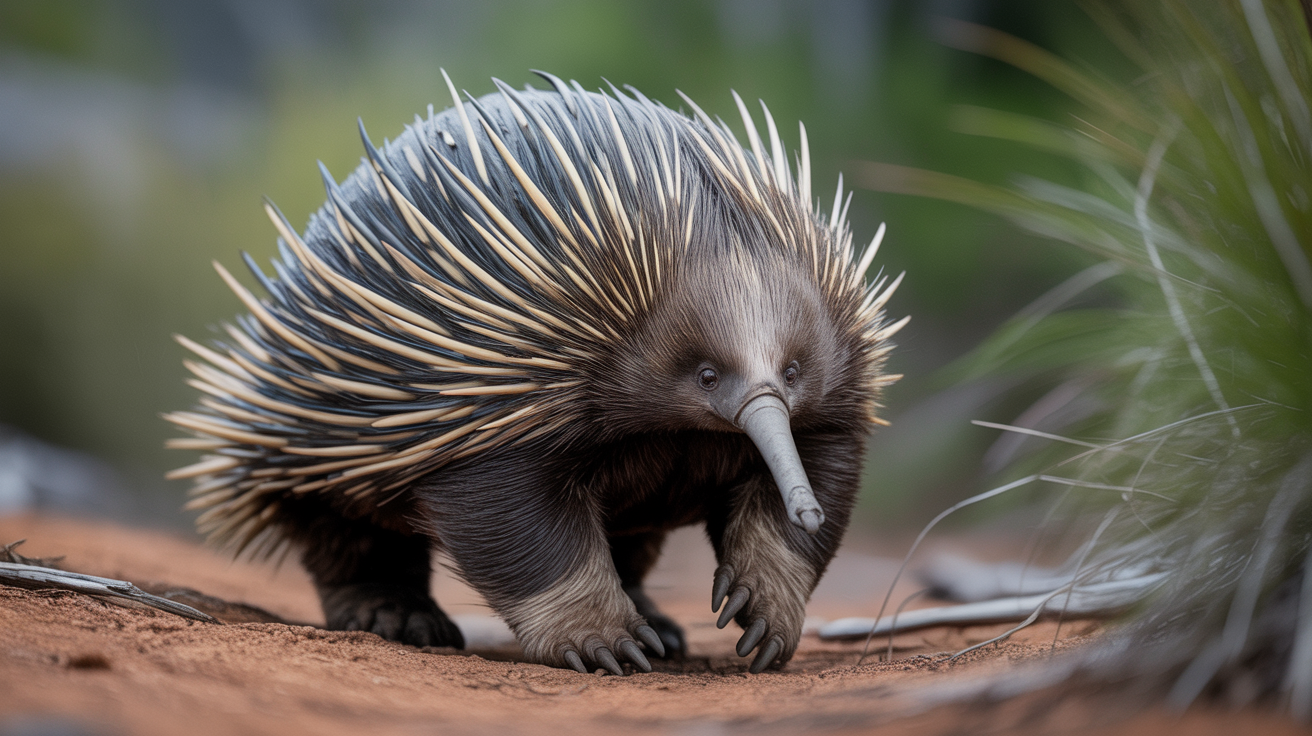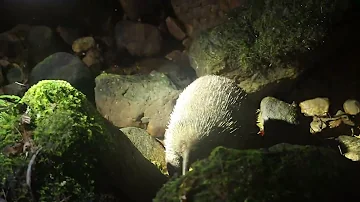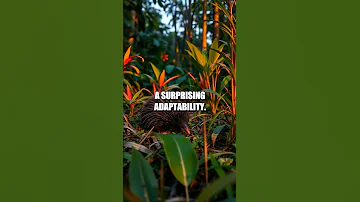
Long-beaked Echidna
Zaglossus bruijni

Meet the Long-beaked Echidna
The Long-beaked Echidna is a spiny, egg-laying mammal native to the rugged highland forests of New Guinea. Unlike its Australian short-beaked cousin, it has an elongated, downward-curving snout, perfectly adapted for probing soil and rotten logs in search of earthworms and insects. Covered in coarse hair and spines, this elusive animal is primarily nocturnal and rarely seen by humans due to its secretive habits. The Long-beaked Echidna also possesses powerful claws for digging and is one of only five extant species of monotremes, a group of mammals that lay eggs instead of giving birth to live young.
Classification
Mammal
Habitat
Montane forests and upland regions
Diet
Carnivore
Lifespan
15-30 years
Conservation
Critically Endangered
Weight
5-10 kg
📖Fascinating Facts
Egg-laying Mammal
The Long-beaked Echidna is a monotreme, one of only five living mammals that lay eggs rather than giving birth to live young.
Highland Specialist
It inhabits the dense, cool highland forests of New Guinea at elevations between 1,300 and 4,000 meters.
Unique Jaw Structure
Unlike most mammals, the Long-beaked Echidna has no teeth, using hard pads in its mouth to grind up worms and insects.
📋Detailed Description
The Long-beaked Echidna (Zaglossus bruijni) is a large monotreme, reaching lengths of 60–100 cm and weighing between 5 and 16 kg, making it the largest extant echidna species. Its most distinctive feature is its elongated, downward-curving snout, which can measure up to 20 cm and houses electroreceptors that detect the faint electrical signals of invertebrate prey. The body is robust and covered in a dense layer of coarse brown to black fur interspersed with sharp keratinous spines up to 6 cm long, providing effective protection against predators. The limbs are short and exceptionally strong, equipped with large, curved claws—particularly on the forelimbs—adapted for powerful digging. Unlike the short-beaked echidna, the hind feet of Zaglossus bruijni are rotated backward, aiding in burrowing and soil displacement. The species lacks teeth; instead, it uses a long, sticky tongue (up to 25 cm) to extract earthworms and insects from soil and decaying wood. The Long-beaked Echidna is primarily nocturnal and crepuscular, emerging at dusk and dawn to forage. It is solitary and highly elusive, with individuals occupying large home ranges in the cool, humid montane forests and subalpine grasslands of New Guinea at elevations from 1,300 to over 4,000 meters. The animal is a vital ecosystem engineer, aerating soil and influencing invertebrate populations through its foraging behavior. As an egg-laying mammal, it exhibits a unique reproductive biology, and its evolutionary lineage dates back over 100 million years, making it a living relic of early mammalian evolution.
💡 Did you know?
The Long-beaked Echidna can lower its body temperature to near ambient levels, making it one of the most cold-tolerant mammals in the tropics.
🔬Research & Sources
Wikipedia Summary
Zaglossus, from Ancient Greek ζα (za), from διά (diá), meaning "across", and γλῶσσα (glôssa), meaning "tongue", known as the long-beaked echidnas make up one of the two extant genera of echidnas: there are three extant species, all living in New Guinea. They are medium-sized, solitary mammals covered with coarse hair and spines made of keratin. They have short, strong limbs with large claws, and are powerful diggers. They forage in leaf litter on the forest floor, eating earthworms and insects.
Last Modified: 5/25/2025
🎭Behavior & Social Structure
Long-beaked Echidnas are solitary and primarily nocturnal, spending daylight hours sheltering in burrows, hollow logs, or dense vegetation. They are slow-moving but capable of rapid digging when threatened, quickly burying themselves to escape predators. Foraging is conducted by probing the soil and leaf litter with their sensitive snout, using electroreceptors to locate earthworms, insect larvae, and other soil invertebrates. They exhibit a methodical, deliberate feeding style, often leaving distinctive foraging pits. Social interactions are minimal outside of the breeding season, and individuals maintain exclusive territories marked by scent glands. Communication is limited, primarily through olfactory cues. Echidnas are known to enter a state of torpor during periods of cold or food scarcity, reducing metabolic rate to conserve energy.
👶Reproduction & Life Cycle
Breeding in Zaglossus bruijni is believed to occur during the wet season (typically June to September), though precise timing may vary regionally. Males locate receptive females via scent trails, and courtship involves following and circling behaviors. After mating, the female lays a single leathery egg directly into a temporary abdominal pouch, where it incubates for about 10 days. Upon hatching, the altricial puggle remains in the pouch for 6–8 weeks, feeding on milk secreted from specialized mammary glands (monotremes lack nipples). Once the young develops spines, the mother transfers it to a burrow or nest, returning periodically to nurse. Weaning occurs at around 7 months, after which the juvenile becomes independent. Parental care is provided exclusively by the female; males do not participate in rearing offspring.
🛡️Adaptations & Survival
The Long-beaked Echidna exhibits several remarkable adaptations. Its elongated, flexible snout is highly sensitive, equipped with over 2,000 electroreceptors that detect electrical signals from prey—a trait shared only with the platypus among mammals. The long, sticky tongue is specialized for rapid extension and retraction, allowing efficient capture of soft-bodied invertebrates. Robust forelimbs and large claws enable powerful digging, essential for both foraging and predator avoidance. The backward-facing hind feet enhance soil displacement during excavation. The dense fur and spines provide insulation and defense, while the animal’s low metabolic rate and ability to enter torpor help it survive in the cool, resource-scarce highland environment. Its reproductive strategy—egg-laying and extended maternal care—reflects an ancient lineage, offering insights into early mammalian evolution.
📚Research Sources
🎨Cultural Significance
The Long-beaked Echidna holds cultural importance for several indigenous communities in New Guinea, where it is known by various local names and features in folklore as a symbol of resilience and earthiness. Traditionally, it has been hunted for its meat and spines, which are sometimes used as tools or ornaments. In some regions, the animal is associated with ancestral spirits and is considered a totemic species. Its rarity and unique biology have also made it a subject of fascination among naturalists and biologists, contributing to its symbolic value as a flagship species for conservation in New Guinea.
🔬Recent Research & Discoveries
Recent research has focused on the echidna’s sensory biology, particularly the function and distribution of electroreceptors in the snout, revealing convergent evolution with the platypus. Genetic studies have clarified the phylogenetic relationships among monotremes, confirming the deep evolutionary divergence of Zaglossus from other mammals. Field surveys using camera traps and environmental DNA (eDNA) have improved understanding of distribution and population status, though data remain limited due to the species’ cryptic habits. Conservation genetics is an emerging area, with studies aiming to assess genetic diversity and inform management strategies. Ongoing research also examines the impact of habitat fragmentation and hunting on population viability.
🎥Wildlife Videos

Echidna | World's Weirdest
#NatGeoWILD #WorldsWeirdest #Echidnas About World's Weirdest: A buffalo with three eyes, an exterminator who eats his day's ...
Nat Geo Animals

The Mysterious Western Long Beaked Echidna Nature's Enigma
Join us on an incredible wildlife adventure as we explore the rare Western Long-Beaked Echidna (Zaglossus bruijni) in this ...
PlanTrip

10 Things You Didn’t Know About Echidnas!
Few creatures are as bizarre as echidnas! So in this video we talk about 10 of the wildest, and weirdest facts, which we think you ...
Wannon Creek Wildlife

A Close Encounter with Endearing Echidnas | The Making of Mammals | BBC Earth
Is it a hedgehog? Is it a porcupine? No, it's an echidna! These spiky ant-eaters are usually solitary creatures, but the combination ...
BBC Earth

Wild Western Long-beaked Echidna, Zaglossus bruijni
A critically endangered Western Long-beaked Echidna (Zaglossus bruijni), near Sorong, West Papua, June 2023. One of the ...
Mammalwatching

The Enigma of the Long-Beaked Echidna
Uncover the secrets of the Long-Beaked Echidna, exploring its mysterious behaviors and survival instincts. #Echidna #Wildlife ...
Animal Unknown - Adam
🌍Habitat Information
The Long-beaked Echidna typically inhabits Montane forests and upland regions environments. Long-beaked Echidnas have adapted to their environments with specialized features and behaviors.
Primary Habitat:
Montane forests and upland regions
More detailed habitat information will be available soon.
🛡️Conservation Status
The Long-beaked Echidna is currently classified as Critically Endangered. Conservation efforts are crucial for preserving this species for future generations.
Common Threats:
- 🏠Habitat loss and fragmentation
- 🌡️Climate change impacts
- 🎯Hunting and poaching
- 🏭Human-wildlife conflict
⚠️Threats & Conservation Challenges
Zaglossus bruijni faces severe threats, primarily from habitat loss due to deforestation, agricultural expansion, and infrastructure development in New Guinea’s highlands. Hunting for meat and traditional medicine poses a significant risk, as the species is considered a delicacy by some indigenous groups. Its slow reproductive rate and solitary habits make populations particularly vulnerable to overexploitation. Additionally, introduced predators such as dogs and feral pigs threaten eggs and juveniles. Climate change may further impact its montane habitat, altering vegetation and prey availability. The IUCN lists the species as Critically Endangered, with population estimates suggesting a rapid decline and highly fragmented distribution. Conservation efforts are hampered by the species’ elusive nature and the remoteness of its habitat.
🔬Scientific Classification
Scientific Name
Zaglossus bruijni
Classification Hierarchy
🔍 About Taxonomic Classification
Taxonomic classification is a hierarchical system used by scientists to classify and organize living organisms based on shared characteristics and evolutionary relationships.
The system moves from broad categories (Kingdom) to increasingly specific ones, with each animal's scientific name typically consisting of its Genus and species.
📝Community Notes
Share your observations and insights about the Long-beaked Echidna with our community of wildlife enthusiasts.
Join Our Community
Sign in to share your observations and connect with fellow wildlife enthusiasts.
Sign In to ContributeNo community notes yet
Be the first to share your observations about the Long-beaked Echidna!
Explore Long-beaked Echidna
Select a tab above to learn more about this amazing animal.
📸Photo Gallery
No photos available for this animal yet.
🌟Discover More Wildlife
Continue your journey of discovery with more fascinating animals from our database
